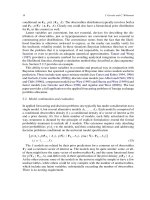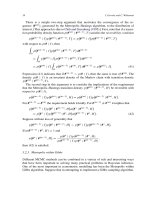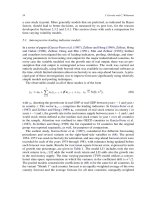Handbook of Economic Forecasting part 42 ppsx
Bạn đang xem bản rút gọn của tài liệu. Xem và tải ngay bản đầy đủ của tài liệu tại đây (107.18 KB, 10 trang )
384 A. Harvey
the discrete time transition equation,
(129)α
τ
= T
τ
α
τ −1
+ η
τ
,τ= 1, ,T
where
(130)T
τ
= exp(Aδ
τ
) = I + Aδ
τ
+
1
2!
A
2
δ
2
τ
+
1
3!
A
3
δ
3
τ
+···
and η
τ
is a multivariate white-noise disturbance term with zero and covariance matrix
(131)Q
τ
=
δ
τ
0
e
A(δ
τ
−s)
RQR
e
A
(δ
τ
−s)
ds.
The condition for α(t) to be stationary is that the real parts of the characteristic roots
of A should be negative. This translates into the discrete time condition that the roots of
T = exp(A) should lie outside the unit circle. If α(t) is stationary, the mean of α(t) is
zero and the covariance matrix is
(132)Var
α(t)
=
0
−∞
e
−As
RQR
e
−A
s
ds.
The initial conditions for α(t
0
) are therefore a
1|0
= 0 and P
1|0
= Var [α(t)].
The main structural components are formulated in continuous time in the following
way.
Trend: In the local level model, the level component, μ(t), is defined by dμ(t) =
σ
η
dW
η
(t), where W
η
(t) is a standard Wiener process and σ
η
is a non-negative para-
meter. Thus the increment dμ(t) has mean zero and variance σ
2
η
dt.
The linear trend component is
(133)
dμ(t)
dβ(t)
=
01
00
μ(t) dt
β(t)dt
+
σ
η
dW
η
(t)
σ
ζ
dW
ζ
(t)
where W
η
(t) and W
ζ
(t) are mutually independent Wiener processes.
Cycle: The continuous cycle is
(134)
dψ(t)
dψ
∗
(t)
=
log ρλ
c
−λ
c
log ρ
ψ(t)dt
ψ
∗
(t) dt
+
σ
κ
dW
κ
(t)
σ
κ
dW
∗
κ
(t)
where W
κ
(t) and W
∗
κ
(t) are mutually independent Wiener processes and σ
κ
, ρ and
λ
c
are parameters, the latter being the frequency of the cycle. The characteristic roots
of the matrix containing ρ and λ
c
are log ρ ± iλ
c
, so the condition for ψ(t) to be a
stationary process is ρ<1.
Seasonal: The continuous time seasonal model is the sum of a suitable number of
trigonometric components, γ
j
(t), generated by processes of the form (134) with ρ
equal to unity and λ
c
set equal to the appropriate seasonal frequency λ
j
for j =
1, ,[s/2].
Ch. 7: Forecasting with Unobserved Components Time Series Models 385
8.2. Stock variables
The discrete state space form for a stock variable generated by a continuoustime process
consists of the transition equation (129) together with the measurement equation
(135)y
τ
= z
α(t
τ
) + ε
τ
= z
α
τ
+ ε
τ
,τ= 1, ,T
where ε
τ
is a white-noise disturbance term with mean zero and variance σ
2
ε
which is
uncorrelated with integrals of η(t) in all time periods. The Kalman filter can therefore
be applied in a standard way. The discrete time model is time-invariant for equally
spaced observations, in which case it is usually convenient to set δ
τ
equal to unity. In
a Gaussian model, estimation can proceed as in discrete time models since, even with
irregularly spaced observations, the construction of the likelihood function can proceed
via the prediction error decomposition.
8.2.1. Structural time series models
The continuous time components defined earlier can be combined to produce a continu-
ous time structural model. As in the discrete case, the components are usually assumed
to be mutually independent. Hence the A and Q matrices are block diagonal and so the
discrete time components can be evaluated separately.
Trend: For a stock observed at times t
τ
, τ = 1, ,T, it follows almost immediately
that if the level component is Brownian motion then
(136)μ
τ
= μ
τ −1
+ η
τ
, Var (η
τ
) = δ
τ
σ
2
η
since
η
τ
= μ(t
τ
) − μ(t
τ −1
) = σ
η
t
τ
t
τ −1
dW
η
(t) = σ
η
W
η
(t
τ
) − W
η
(t
τ −1
)
.
The discrete model is therefore a random walk for equally spaced observations. If the
observation at time τ is made up of μ(t
τ
) plus a white noise disturbance term, ε
τ
,the
discrete time measurement equation can be written
(137)y
τ
= μ
τ
+ ε
τ
, Var (ε
τ
) = σ
2
ε
,τ= 1, ,T
and the set-up corresponds exactly to the familiar random walk plus noise model with
signal–noise ratio q
δ
= δσ
2
η
/σ
2
ε
= δq.
For the local linear trend model
(138)
μ
τ
β
τ
=
1 δ
τ
01
μ
τ −1
β
τ −1
+
η
τ
ζ
τ
.
386 A. Harvey
In view of the simple structure of the matrix exponential, the evaluation of the covari-
ance matrix of the discrete time disturbances can be carried out directly, yielding
(139)Var
η
τ
ζ
τ
= δ
τ
⎡
⎢
⎢
⎢
⎣
σ
2
η
+
1
3
δ
2
τ
σ
2
ζ
.
.
.
1
2
δ
τ
σ
2
ζ
···············
.
.
. ·········
1
2
δ
τ
σ
2
ζ
.
.
.σ
2
ζ
⎤
⎥
⎥
⎥
⎦
When δ
τ
is equal to unity, the transition equation is of the same form as the discrete
time local linear trend (17). However, (139) shows that independence for the contin-
uous time disturbances implies that the corresponding discrete time disturbances are
correlated.
When σ
2
η
= 0, signal extraction with this model yields a cubic spline. Harvey and
Koopman (2000) argue that this is a good way of carrying out nonlinear regression.
The fact that a model is used means that the problem of making forecasts from a
cubic spline is solved.
Cycle: For the cycle model, use of the matrix exponential definition together with the
power series expansions for the cosine and sine functions gives the discrete time
model
(140)
ψ
τ
ψ
∗
τ
= ρ
δ
cos λ
c
δ
τ
sin λ
c
δ
τ
−sin λ
c
δ
τ
cos λ
c
δ
τ
ψ
τ −1
ψ
∗
τ −1
+
κ
τ
κ
∗
τ
.
When δ
τ
equals one, the transition matrix corresponds exactly to the transition matrix
of the discrete time cyclical component. Specifying that κ(t) and κ
∗
(t) be indepen-
dent of each other with equal variances implies that
Var
κ
τ
κ
∗
τ
=
σ
2
κ
log ρ
−2
1 − ρ
2δ
τ
I.
If ρ = 1, the covariance matrix is simply σ
2
κ
δ
τ
I.
8.2.2. Prediction
In the general model of (128), the optimal predictor of the state vector for any positive
lead time, l, is given by the forecast function
(141)a(t
T
+ l | T)= e
Al
a
T
with associated MSE matrix
(142)P(t
T
+ l | T)= T
l
P
T
T
l
+ RQ
l
R
,l>0
where T
l
and Q
l
are, respectively (130) and (131) evaluated with δ
τ
set equal to l.
The forecast function for the systematic part of the series,
(143)
y(t) = z
α(t)
Ch. 7: Forecasting with Unobserved Components Time Series Models 387
can also be expressed as a continuous function of l, namely,
y(t
T
+ l | T)= z
e
Al
a
T
.
The forecast of an observation made at time t
T
+ l,is
(144)y
T +1|T
=
y(t
T
+ l | T)
where the observation to be forecast has been classified as the one indexed τ = T + 1;
its MSE is
MSE
y
T +1|T
= z
P(t
T
+ l | T)z + σ
2
ε
.
The evaluation of forecast functions for the various structural models is relatively
straightforward. In general they take the same form as for the corresponding discrete
time models. Thus the local level model has a forecast function
y(t
T
+ l | T)= m(t
T
+ l | T)= m
T
and the MSE of the forecast of the (T + 1)-th observation, at time t
T
+ l,is
MSE
y
T +1|T
= p
T
+ lσ
2
η
+ σ
2
ε
which is exactly the same form as (15).
8.3. Flow variables
For a flow
(145)y
τ
=
δ
τ
0
z
α(t
τ −1
+ r) + σ
ε
δ
τ
0
dW
ε
(t
τ −1
+ r), τ = 1, ,T
where W
ε
(t) is independent of the Brownian motion driving the transition equation.
Thus the irregular component is cumulated continuously whereas in the stock case it
only comes into play when an observation is made.
The key feature in the treatment of flow variables in continuous time is the introduc-
tion of a cumulator variable, y
f
(t), into the state space model. The cumulator variable
for the series at time t
τ
is equal to the observation, y
τ
,forτ = 1, ,T, that is
y
f
(t
τ
) = y
τ
. The result is an augmented state space system
(146)
α
τ
y
τ
=
e
Aδ
0
z
W(δ
τ
) 0
α
τ −1
y
τ −1
+
I0
0
z
η
τ
η
f
τ
+
0
ε
f
τ
,
y
τ
=[0
1]
α
τ
y
τ
,τ= 1, ,T
with Var(ε
f
τ
) = δ
τ
σ
2
ε
,
(147)W(r) =
r
0
e
As
ds
388 A. Harvey
and
Var
η
τ
η
f
τ
=
δ
τ
0
⎡
⎢
⎢
⎢
⎣
e
Ar
RQR
e
A
r
.
.
. e
Ar
RQR
W
(r)
···············
.
.
. ·········
W(r)RQR
e
A
r
.
.
. W(r)RQR
W
(r)
⎤
⎥
⎥
⎥
⎦
= Q
†
τ
.
Maximum likelihood estimators of the hyperparameters can be constructed via the
prediction error decomposition by running the Kalman filter on (146). No additional
starting value problems are caused by bringing the cumulator variable into the state
vector as y
f
(t
0
) = 0.
An alternative way of approaching the problem is not to augment the state vector, as
such, but to treat the equation
(148)y
τ
= z
W(δ
τ
)α
τ −1
+ z
η
f
τ
+ ε
f
τ
as a measurement equation. Redefining α
τ −1
as α
∗
τ
enables this equation to be written
as
(149)y
τ
= z
τ
α
∗
τ
+ ε
τ
,τ= 1, ,T
where z
τ
= z
W(δ
τ
) and ε
τ
= z
η
f
τ
+ ε
f
τ
. The corresponding transition equation is
(150)α
∗
τ +1
= T
τ +1
α
∗
τ
+ η
τ
,τ= 1, ,T
where T
τ +1
= exp(Aδ
τ
). Taken together these two equations are a system of the
form (53) and (55) with the measurement equation disturbance, ε
τ
, and the transition
equation disturbance, η
τ
, correlated. The covariance matrix of [η
τ
ε
τ
]
is given by
(151)Var
η
τ
ε
τ
=
Q
τ
g
τ
g
τ
h
τ
=
I0
0
z
Q
†
τ
I0
0z
+
00
0 δ
τ
σ
2
ε
.
The modified version of the Kalman filter needed to handle such systems is described
in Harvey (1989, Section 3.2.4). It is possible to find a SSF in which the measurement
error is uncorrelated with the state disturbances, but this is at the price of introducing
a moving average into the state disturbances; see Bergstrom (1984) and Chambers and
McGarry (2002, p. 395).
The various matrix exponential expressions that need to be computed for the flow
variable are relatively easy to evaluate for trend and seasonal components in STMs.
8.3.1. Prediction
In making predictions for a flow it is necessary to distinguish between the total accumu-
lated effect from time t
τ
to time t
τ
+l and the amount of the flow in a single time period
ending at time t
τ
+l. The latter concept corresponds to the usual idea of prediction in a
discrete model.
Ch. 7: Forecasting with Unobserved Components Time Series Models 389
Cumulative predictions. Let y
f
(t
T
+ l) denote the cumulative flow from the end of
the sample to time t
T
+ l. In terms of the state space model of (146) this quantity is
y
T +1
with δ
T +1
set equal to l. The optimal predictor, y
f
(t
T
+ l | T), can therefore be
obtained directly from the Kalman filter as y
T +1|T
. In fact the resulting expression gives
the forecast function which we can write as
(152)y
f
(t
T
+ l | T)= z
W(l)a
T
,l 0
with
(153)MSE
y
f
(t
T
+ l | T)
= z
W(l)P
T
W
(l)z + z
Var
η
f
τ
z + Va r
ε
f
T +1
.
For the local linear trend,
y
f
(t
T
+ l | T)= lm
T
+
1
2
l
2
b
T
,l 0
with
MSE
y
f
(t
T
+ l | T)
= l
2
p
(1,1)
T
+ l
3
p
(1,2)
T
+
1
4
l
4
p
(2,2)
T
+
1
3
l
3
σ
2
η
(154)+
1
20
l
5
σ
2
ζ
+ lσ
2
ε
where p
(i,j )
T
is the (i, j)th element of P
T
. Because the forecasts from a linear trend are
being cumulated, the result is a quadratic. Similarly, the forecast for the local level, lm
T
,
is linear.
Predictions over the unit interval. Predictions over the unit interval emerge quite nat-
urally from the state space form, (146), as the predictions of y
T +l
,l = 1, 2, , with
δ
T +l
set equal to unity for all l. Thus,
(155)y
T +l|T
= z
W(1)a
T +l−1|T
,l= 1, 2,
with
(156)a
T +l−1|T
= e
A(l−1)
a
T
,l= 1, 2,
The forecast function for the state vector is therefore of the same form as in the corre-
sponding stock variable model. The presence of the term W(1) in (155) leads to a slight
modification when these forecasts are translated into a prediction for the series itself.
For STMs, the forecast functions are not too different from the corresponding discrete
time forecast functions. However, an interesting feature is that pattern of weighting
functions is somewhat more general. For example, for a continuous time local level, the
MA parameter in the ARIMA(0, 1, 1) reduced form can take values up to 0.268 and the
smoothing constant in the EWMA used to form the forecasts is in the range 0 to 1.268.
390 A. Harvey
8.3.2. Cumulative predictions over a variable lead time
In some applications, the lead time itself can be regarded as a random variable. This
happens, for example, in inventory control problems where an order is put in to meet
demand, but the delivery time is uncertain. In such situations it may be useful to de-
termine the unconditional distribution of the flow from the current point in time, that
is
(157)p
y
f
T
=
∞
0
p
y
f
(t
T
+ l | T
p(l) dl
where p(l) is the p.d.f. of the lead time and p(y
f
(t
T
+ l | T)) is the distribution of
y
f
(t
T
+ l) conditional on the information at time T . In a Gaussian model, the mean
of y
f
(t
T
+ l) is given by (152), while its variance is the same as the expression for
the MSE of y
f
(t
T
+ l) given in (153). Although it may be difficult to derive the full
unconditional distribution of y
f
T
, expressions for the mean and variance of this distrib-
ution may be obtained for the principal structural time series models. In the context of
inventory control, the unconditional mean might be the demand expected in the period
before a new delivery arrives.
The mean of the unconditional distribution of y
f
T
is
(158)E
y
f
T
= E
y
f
(t
T
+ l | T)
where the expectation is with respect to the distribution of the lead time. Similarly, the
unconditional variance is
(159)Var
y
f
T
= E
y
f
(t
T
+ l | T)
2
−
E
y
f
T
2
where the second raw moment of y
f
T
can be obtained as
E
y
f
(t
T
+ l | T)
2
= MSE
y
f
(t
T
+ l | T)
+
y
f
(t
T
+ l | T)
2
.
The expressions for the mean and variance of y
f
T
depend on the moments of the distri-
bution of the lead time. This can be illustrated by the local level model. Let the j th raw
moment of this distribution be denoted by μ
j
, with the mean abbreviated to μ. Then,
by specializing (154),
E
y
f
T
= E(lm
T
) = E(l)m
T
= μm
T
and
(160)Var
y
f
T
= m
2
T
Var (l) + μσ
2
ε
+ μ
2
p
T
+
1
3
μ
3
σ
2
η
.
The first two terms are the standard formulae found in the operational research literature,
corresponding to a situation in which σ
2
η
is zero and the (constant) mean is known. The
third term allows for the estimation of the mean, which now may or may not be constant,
Ch. 7: Forecasting with Unobserved Components Time Series Models 391
while the fourth term allows for the movements in the mean that take place beyond the
current time period.
The extension to the local linear trend and trigonometric seasonal components is dealt
with in Harvey and Snyder (1990). As regards the lead time distribution, it may be pos-
sible to estimate moments from past observations. Alternatively, a particular distribution
may be assumed. Snyder (1984) argues that the gamma distribution has been found to
work well in practice.
9. Nonlinear and non-Gaussian models
In the linear state space form set out at the beginning of Section 6 the system matrices
are non-stochastic and the disturbances are all white noise. The system is rather flexi-
ble in that the system matrices can vary over time. The additional assumption that the
disturbances and initial state vector are normally distributed ensures that we have a lin-
ear model, that is, one in which the conditional means (the optimal estimates) of future
observations and components are linear functions of the observations and all other char-
acteristics of the conditional distributions are independent of the observations. If there
is only one disturbance term, as in an ARIMA model, then serial independence of the
disturbances is sufficient for the model to be linear, but with unobserved components
this is not usually the case.
Non-linearities can be introduced into state space models in a variety of ways. A com-
pletely general formulation is laid out in the first subsection below, but more tractable
classes of models are obtained by focussing on different sources of non-linearity. In
the first place, the time-variation in the system matrices may be endogenous. This
opens up a wide range of possibilities for modelling with the stochastic system ma-
trices incorporating feedback in that they depend on past observations or combinations
of observations. The Kalman filter can still be applied when the models are condition-
ally Gaussian, as described in Section 9.2. A second source of nonlinearity arises in
an obvious way when the measurement and/or transition equations have a nonlinear
functional form. Finally the model may be non-Gaussian. The state space may still be
linear as for example when the measurement equation has disturbances generated by a
t-distribution. More fundamentally non-normality may be intrinsic to the data. Thus the
observations may be count data in which the number of events occurring in each time
period is recorded. If these numbers are small, a normal approximation is unreasonable
and in order to be data-admissible the model should explicitly take account of the fact
that the observations must be non-negative integers. A more extreme example is when
the data are dichotomous and can take one of only two values, zero and one. The struc-
tural approach to time series model-building attempts to take such data characteristics
into account.
Count data models are usually based on distributions like the Poisson and negative bi-
nomial. Thus the non-Gaussianity implies a nonlinear measurement equation that must
somehow be combined with a mechanism that allows the mean of the distribution to
392 A. Harvey
change over time. Section 9.3.1 sets out a class of models which deal with non-Gaussian
distributions for the observations by means of conjugate filters. However, while these
filters are analytic, the range of dynamic effects that can be handled is limited. A more
general class of models is considered in Section 9.3.2. The statistical treatment of such
models depends on applying computer intensive methods. Considerable progress has
been made in recent years in both a Bayesian and classical framework.
When the state variables are discrete, a whole class of models can be built up based
on Markov chains. Thus there is intrinsic non-normality in the transition equations and
this may be combined with feedback effects. Analytic filters are possible in some cases
such as the autoregressive models introduced by Hamilton (1989).
In setting up nonlinear models, there is often a choice between what Cox calls ‘para-
meter driven’ models, based on a latent or unobserved process, and ‘observation driven’
models in which the starting point is a one-step ahead predictive distribution. As a gen-
eral rule, the properties of parameter driven models are easier to derive, but observation
driven models have the advantage that the likelihood function is immediately available.
This survey concentrates on parameter driven models, though it is interesting that some
models, such as the conjugate ones of Section 9.3.1, belong to both classes.
9.1. General state space model
In the general formulation of a state space model, the distribution of the observations is
specified conditional on the current state and past observations, that is,
(161)p(y
t
| α
t
, Y
t−1
)
where Y
t−1
={y
t−1
, y
t−2
, }. Similarly the distribution of the current state is speci-
fied conditional on the previous state and observations, so that
(162)p(α
t
| α
t−1
, Y
t−1
).
The initial distribution of the state, p(α
0
) is also specified. In a linear Gaussian model
the conditional distributions in (161) and (162) are characterized by their first two mo-
ments and so they are specified by the measurement and transition equations.
Filtering: The statistical treatment of the general state space model requires the deriva-
tion of a recursion for p(α
t
| Y
t
), the distribution of the state vector conditional on
the information at time t. Suppose this is given at time t − 1. The distribution of α
t
conditional on Y
t−1
is
p(α
t
| Y
t−1
) =
∞
−∞
p(α
t
, α
t−1
| Y
t−1
) dα
t−1
but the right-hand side may be rearranged as
(163)p(α
t
| Y
t−1
) =
∞
−∞
p(α
t
| α
t−1
, Y
t−1
)p(α
t−1
| Y
t−1
) dα
t−1
.
Ch. 7: Forecasting with Unobserved Components Time Series Models 393
The conditional distribution p(α
t
| α
t−1
, Y
t−1
) is given by (162) and so p(α
t
| Y
t−1
)
may, in principle, be obtained from p(α
t−1
| Y
t−1
).
As regards updating,
p(α
t
| Y
t
) = p(α
t
| y
t
, Y
t−1
) =
p(α
t
, y
t
| Y
t−1
)
p(y
t
| Y
t−1
)
(164)=
p(y
t
| α
t
, Y
t−1
)p(α
t
| Y
t−1
)
p(y
t
| Y
t−1
)
where
(165)p(y
t
| Y
t−1
) =
∞
−∞
p(y
t
| α
t
, Y
t−1
)p(α
t
| Y
t−1
) dα
t
.
The likelihood function may be constructed as the product of the predictive distribu-
tions, (165),asin(68).
Prediction: Prediction is effected by repeated application of (163), starting from
p(α
T
| Y
T
),togivep(α
T +l
| Y
T
). The conditional distribution of y
T +l
is then
obtained by evaluating
(166)p(y
T +l
| Y
T
) =
∞
−∞
p(y
T +l
| α
T +l
, Y
T
)p(α
T +l
| Y
T
) dα
T +l
.
An alternative route is based on noting that the predictive distribution of y
T +l
for
l>1 is given by
(167)p(y
T +l
| Y
T
) =
l
j=1
p(y
T +j
| Y
T +j −1
) dy
T +j
dy
T +l−1
.
This expression follows by observing that the joint distribution of the future observa-
tions may be written in terms of conditional distributions, that is
p(y
T +l
, y
T +l−1
, ,y
T +1
| Y
T
) =
l
j=1
p(y
T +j
| Y
T +j −1
).
The predictive distribution of y
T +l
is then obtained as a marginal distribution by
integrating out y
T +1
to y
T +l−1
. The usual point forecast is the conditional mean
(168)E(y
T +l
| Y
T
) =
E
T
(y
T +l
) =
∞
−∞
y
T +l
p(y
T +l
| Y
T
) dy
T +l
as this is the minimum mean square estimate. Other point estimates may be con-
structed. In particular the maximum a posteriori estimate is the mode of the condi-
tional distribution. However, once we move away from normality, there is a case for
expressing forecasts in terms of the whole of the predictive distribution.









